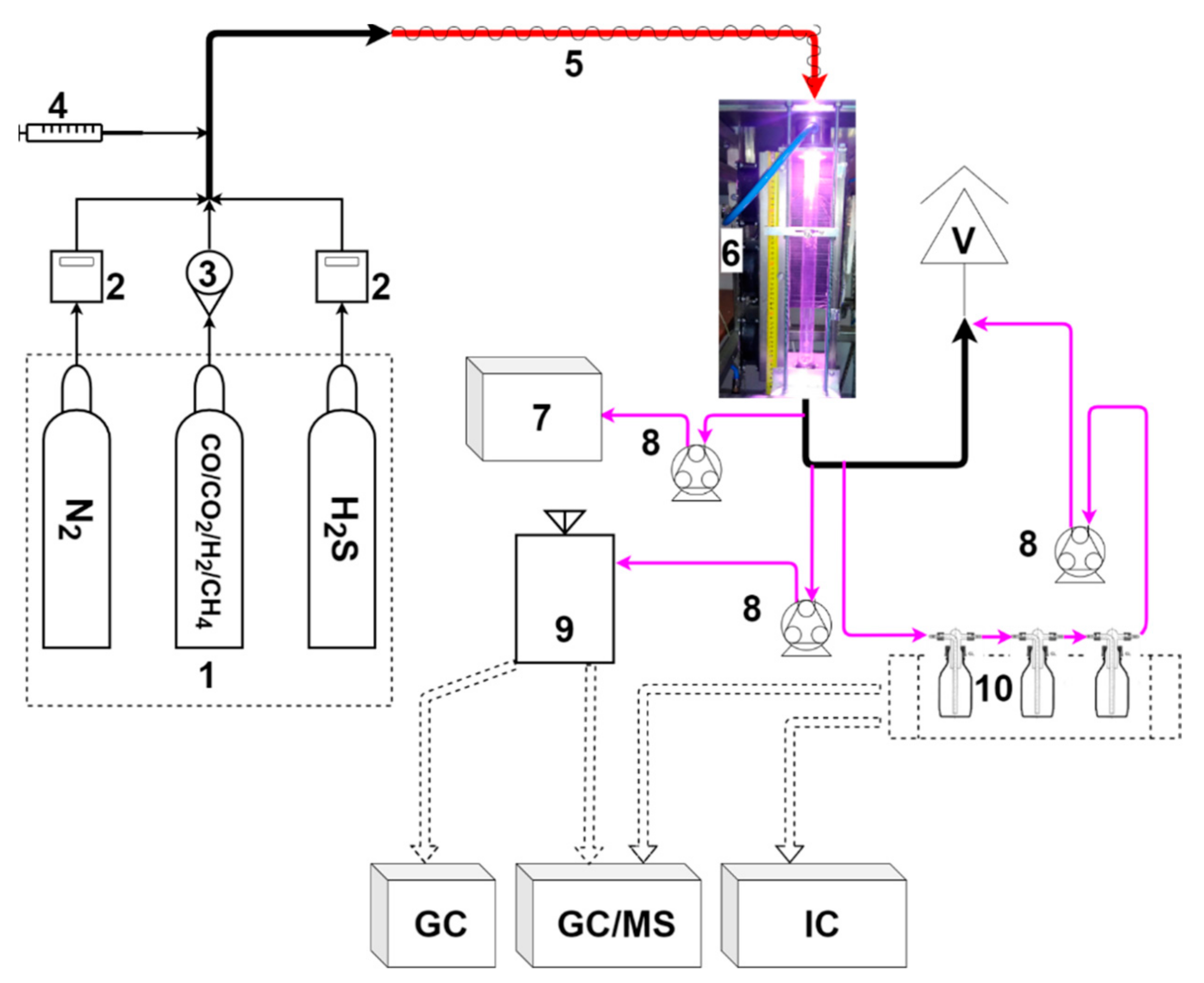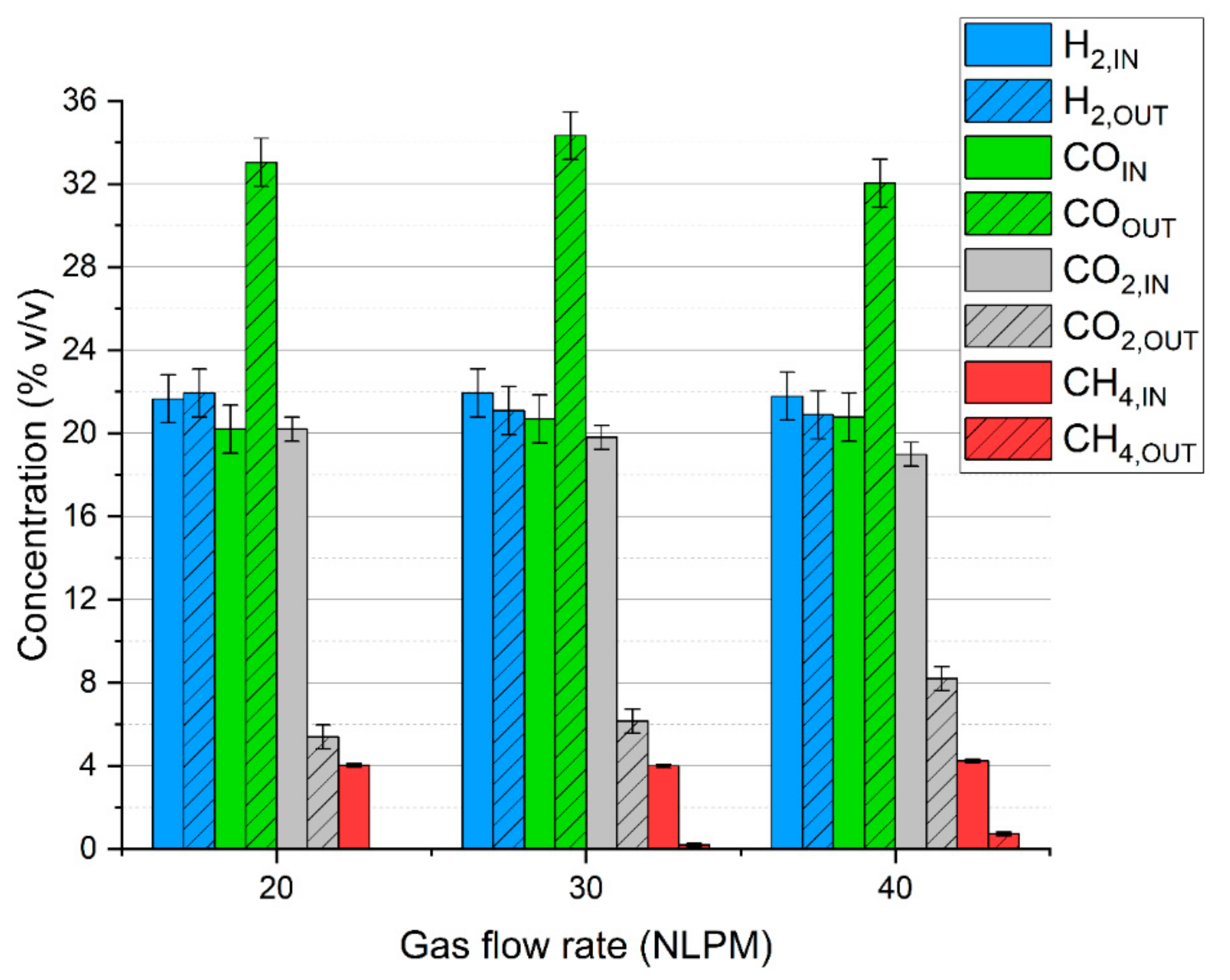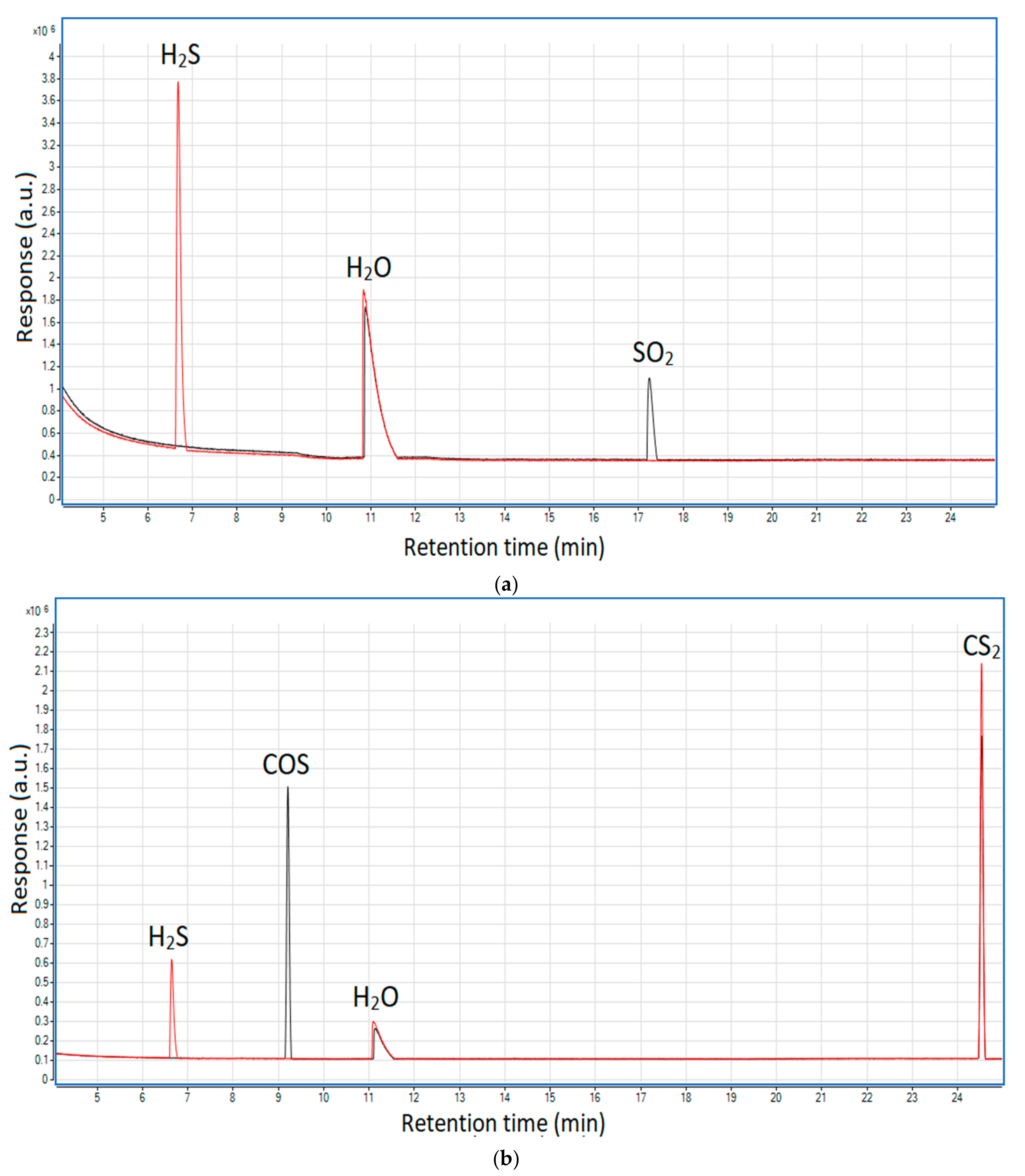Warm Plasma Application in Tar Conversion and Syngas Valorization: The Fate of Hydrogen Sulfide
Abstract
:1. Introduction
2. Materials and Methods
2.1. The Experimental Setup
2.2. Assessment Methods
2.3. Uncertainty of Measurement
3. Results and Discussion
3.1. MW Plasma Impact on Syngas Composition
3.2. Hydrogen Sulfide Conversion
4. Conclusions
- The presence of carbon monoxide, carbon dioxide, methane, and toluene in syngas leads to the formation of carbonyl sulfide, sulfur dioxide, carbon disulfide, and benzothiophene, respectively.
- The abundance of hydrogen in syngas leads to the recreation of hydrogen sulfide at the cost of carbonyl sulfide and sulfur dioxide.
- Consequently, the conversion rate of hydrogen sulfide in syngas is rather low. The main sulfur compound in the outlet stream of the processed gas is hydrogen sulfide. The share of the rest of sulfur products can be presented followingly: CS2 > COS >> sulfates, and benzothiophene.
Author Contributions
Funding
Institutional Review Board Statement
Informed Consent Statement
Data Availability Statement
Conflicts of Interest
References
- Buchireddy, P.R.; Peck, D.; Zappi, M.; Bricka, R.M. Catalytic hot gas cleanup of biomass gasification producer gas via steam reforming using nickel-supported clay minerals. Energies 2021, 14, 1875. [Google Scholar] [CrossRef]
- Molino, A.; Larocca, V.; Chianese, S.; Musmarra, D. Biofuels production by biomass gasification: A review. Energies 2018, 11, 811. [Google Scholar] [CrossRef] [Green Version]
- Rueda, Y.G.; Helsen, L. The role of plasma in syngas tar cracking. Biomass Convers. Biorefinery 2020, 10, 857–871. [Google Scholar] [CrossRef]
- Saleem, F.; Harris, J.; Zhang, K.; Harvey, A. Non-thermal plasma as a promising route for the removal of tar from the product gas of biomass gasification—A critical review. Chem. Eng. J. 2020, 382, 122761. [Google Scholar] [CrossRef]
- Pemen, A.J.M.; Nair, S.A.; Yan, K.; Van Heesch, E.J.M.; Ptasinski, K.J.; Drinkenburg, A.A.H. Pulsed corona discharges for tar removal from biomass derived fuel gas. Plasmas Polym. 2003, 8, 209–224. [Google Scholar] [CrossRef]
- Gomez-Rueda, Y.; Zaini, I.N.; Yang, W.; Helsen, L. Thermal tar cracking enhanced by cold plasma—A study of naphthalene as tar surrogate. Energy Convers. Manag. 2020, 208, 112540. [Google Scholar] [CrossRef]
- Dors, M.; Kurzyńska, D. Tar removal by nanosecond pulsed dielectric barrier discharge. Appl. Sci. 2020, 10, 991. [Google Scholar] [CrossRef] [Green Version]
- Saleem, F.; Khoja, A.H.; Umer, J.; Ahmad, F.; Abbas, S.Z.; Zhang, K.; Harvey, A. Removal of benzene as a tar model compound from a gas mixture using non-thermal plasma dielectric barrier discharge reactor. J. Energy Inst. 2021, 96, 97–105. [Google Scholar] [CrossRef]
- Saleem, F.; Rehman, A.; Abbas, A.; Hussain Khoja, A.; Ahmad, F.; Liu, L.; Zhang, K.; Harvey, A. A comparison of the decomposition of biomass gasification tar compound in CO, CO2, H2 and N2 carrier gases using non-thermal plasma. J. Energy Inst. 2021, 97, 161–168. [Google Scholar] [CrossRef]
- Materazzi, M.; Lettieri, P.; Mazzei, L.; Taylor, R.; Chapman, C. Tar evolution in a two stage fluid bed-plasma gasification process for waste valorization. Fuel Process. Technol. 2014, 128, 146–157. [Google Scholar] [CrossRef]
- Nunnally, T.; Tsangaris, A.; Rabinovich, A.; Nirenberg, G.; Chernets, I.; Fridman, A. Gliding arc plasma oxidative steam reforming of a simulated syngas containing naphthalene and toluene. Int. J. Hydrogen Energy 2014, 39, 11976–11989. [Google Scholar] [CrossRef]
- Xu, R.; Zhu, F.; Zhang, H.; Ruya, P.M.; Kong, X.; Li, L.; Li, X. Simultaneous removal of toluene, naphthalene, and phenol as tar surrogates in a rotating gliding arc discharge reactor. Energy Fuels 2020, 34, 2045–2054. [Google Scholar] [CrossRef]
- Zhu, F.; Zhang, H.; Yang, H.; Yan, J.; Li, X.; Tu, X. Plasma reforming of tar model compound in a rotating gliding arc reactor: Understanding the effects of CO2 and H2O addition. Fuel 2020, 259, 116271. [Google Scholar] [CrossRef]
- Mei, D.; Zhang, P.; Liu, S.; Ding, L.; Ma, Y.; Zhou, R.; Gu, H.; Fang, Z.; Cullen, P.J.; Tu, X. Highly efficient reforming of toluene to syngas in a gliding arc plasma reactor. J. Energy Inst. 2021, 98, 131–143. [Google Scholar] [CrossRef]
- Xu, R.; Zhang, H.; Zhu, F.; Ruya, P.M.; Yan, J.; Li, X. Plasma conversion of toluene, naphthalene, and phenol as model tar compounds in simulated synthetic gas. Chem. Lett. 2021, 50, 265–268. [Google Scholar] [CrossRef]
- Jamróz, P.; Kordylewski, W.; Wnukowski, M. Microwave plasma application in decomposition and steam reforming of model tar compounds. Fuel Process. Technol. 2017, 169, 1–14. [Google Scholar] [CrossRef]
- Eliott, R.M.; Nogueira, M.F.M.; Silva Sobrinho, A.S.; Couto, B.A.P.; MacIel, H.S.; Lacava, P.T. Tar reforming under a microwave plasma torch. Energy Fuels 2013, 27, 1174–1181. [Google Scholar] [CrossRef]
- Xie, Q.; Borges, F.C.; Cheng, Y.; Wan, Y.; Li, Y.; Lin, X.; Liu, Y.; Hussain, F.; Chen, P.; Ruan, R. Fast microwave-assisted catalytic gasification of biomass for syngas production and tar removal. Bioresour. Technol. 2014, 156, 291–296. [Google Scholar] [CrossRef] [PubMed]
- van Rooij, G.J.; van den Bekerom, D.C.M.; den Harder, N.; Minea, T.; Berden, G.; Bongers, W.A.; Engeln, R.; Graswinckel, M.F.; Zoethout, E.; van de Sanden, M.C.M. Taming microwave plasma to beat thermodynamics in CO 2 dissociation. Faraday Discuss. 2015, 183, 233–248. [Google Scholar] [CrossRef] [Green Version]
- Cerone, N.; Zimbardi, F. Effects of oxygen and steam equivalence ratios on updraft gasification of biomass. Energies 2021, 14, 2675. [Google Scholar] [CrossRef]
- Knoef, H.A.M. Success stories. In Handbook Biomass Gasification; Knoef, H.A.M., Ed.; BTG Biomass Technology Group: Enschede, The Netherlands, 2012. [Google Scholar]
- Bartholomew, C.H.; Agrawal, P.K.; Katzer, J.R. Sulfur poisoning of metals. Adv. Catal. 1982, 31, 135–242. [Google Scholar] [CrossRef]
- Kaufman Rechulski, M.D.; Schildhauer, T.J.; Biollaz, S.M.A.; Ludwig, C. Sulfur containing organic compounds in the raw producer gas of wood and grass gasification. Fuel 2014, 128, 330–339. [Google Scholar] [CrossRef]
- Koido, K.; Watanabe, Y.; Ishiyama, T.; Nunoura, T.; Dowaki, K. Fate of sulphur during simultaneous gasification of lignin-slurry and removal of hydrogen sulphide over calcium aluminate supported nickel oxide catalyst. J. Clean. Prod. 2017, 141, 568–579. [Google Scholar] [CrossRef]
- Meng, X.; De Jong, W.; Pal, R.; Verkooijen, A.H.M. In bed and downstream hot gas desulphurization during solid fuel gasification: A review. Fuel Process. Technol. 2010, 91, 964–981. [Google Scholar] [CrossRef]
- Materazzi, M.; Lettieri, P.; Mazzei, L.; Taylor, R.; Chapman, C. Reforming of tars and organic sulphur compounds in a plasma-assisted process for waste gasification. Fuel Process. Technol. 2015, 137, 259–268. [Google Scholar] [CrossRef]
- Pacheco Gomez, F.J. Mechanism of Sulfur Poisoning by H2S and SO2 of Nickel and Cobalt Based Catalysts for Dry Reforming of Methane. Ph.D. Thesis, University of Saskatchewan, Saskatoon, Saskatchewan, 2016. [Google Scholar]
- Mousavi, S.M.A.; Piavis, W.; Turn, S. Reforming of biogas using a non-thermal, gliding-arc, plasma in reverse vortex flow and fate of hydrogen sulfide contaminants. Fuel Process. Technol. 2019, 193, 378–391. [Google Scholar] [CrossRef]
- Hongrapipat, J.; Saw, W.L.; Pang, S. Co-gasification of blended lignite and wood pellets in a dual fluidized bed steam gasifier: The influence of lignite to fuel ratio on NH3 and H2S concentrations in the producer gas. Fuel 2015, 139, 494–501. [Google Scholar] [CrossRef]
- Wnukowski, M.; Jamróz, P.; Niedzwiecki, L. The role of hydrogen in microwave plasma valorization of producer gas. Int. J. Hydrogen Energy 2021. [Google Scholar] [CrossRef]
- Wnukowski, M.; Jamróz, P. Microwave plasma treatment of simulated biomass syngas: Interactions between the permanent syngas compounds and their influence on the model tar compound conversion. Fuel Process. Technol. 2018, 173, 229–242. [Google Scholar] [CrossRef]
- Liu, M.; Aravind, P.V. The fate of tars under solid oxide fuel cell conditions: A review. Appl. Therm. Eng. 2014, 70, 687–693. [Google Scholar] [CrossRef]
- Boerrigter, H.; Calis, H.; Slort, D.J.; Bodenstaff, H.; Kaandorp, A.; Uil, H.; Rabou, L. Gas cleaning for integrated biomass gasification (BG) and Fischer-Tropsch (FT) systems experimental demonstration of two BG-FT systems (Proof-of-Principle). 2004. Report of the Energy research Centre of the Netherlands (ECN) (Report No. ECN-C-04-056). Available online: https://publications.tno.nl/publication/34628436/D9t08A/c04056.pdf (accessed on 27 August 2021).
- Wnukowski, M.; Kordylewski, W.; Łuszkiewicz, D.; Leśniewicz, A.; Ociepa, M.; Michalski, J. Sewage Sludge-Derived Producer Gas Valorization with the Use of Atmospheric Microwave Plasma. Waste Biomass Valorization 2019, 11, 4289–4303. [Google Scholar] [CrossRef] [Green Version]
- Van Der Drift, A.; Van Doorn, J.; Vermeulen, J.W. Ten residual biomass fuels for circulating fluidized-bed gasification. Biomass Bioenergy 2001, 20, 45–56. [Google Scholar] [CrossRef]
- Cheah, S.; Carpenter, D.L.; Magrini-Bair, K.A. Review of mid- to high-temperature sulfur sorbents for desulfurization of biomass- and coal-derived syngas. Energy Fuels 2009, 23, 5291–5307. [Google Scholar] [CrossRef]
- Yu, J.; Chang, L.; Xie, W.; Wang, D. Correlation of H2S and COS in the hot coal gas stream and its importance for high temperature desulfurization. Korean J. Chem. Eng. 2011, 28, 1054–1057. [Google Scholar] [CrossRef]
- Karan, K.; Behie, L.A. CS2 formation in the claus reaction furnace: A kinetic study of methane-sulfur and methane-hydrogen sulfide reactions. Ind. Eng. Chem. Res. 2004, 43, 3304–3313. [Google Scholar] [CrossRef]
- Feng, T.; Huo, M.; Zhao, X.; Wang, T.; Xia, X.; Ma, C. Reduction of SO2 to elemental sulfur with H2 and mixed H2/CO gas in an activated carbon bed. Chem. Eng. Res. Des. 2017, 121, 191–199. [Google Scholar] [CrossRef]
- Zhang, R.; Ling, L.; Wang, B. Theoretical studies on reaction mechanism of H2 with COS. J. Mol. Model. 2010, 16, 1911–1917. [Google Scholar] [CrossRef]
- Kamp, E.; Thielert, H.; Von Morstein, O.; Kureti, S.; Schreiter, N.; Repke, J.U. Investigation on the simultaneous removal of COS, CS2 and O2 from coke oven gas by hydrogenation on a Pd/Al2O3 catalyst. Catal. Sci. Technol. 2020, 10, 2961–2969. [Google Scholar] [CrossRef]
- Shangguan, J.; Zhao, Y.; Fan, H.; Liang, L.; Shen, F.; Miao, M. Desulfurization behavior of zinc oxide based sorbent modified by the combination of Al2O3 and K2CO3. Fuel 2013, 108, 80–84. [Google Scholar] [CrossRef]
- Rhodes, C.; Riddel, S.A.; West, J.; Williams, B.P.; Hutchings, G.J. Low-temperature hydrolysis of carbonyl sulfide and carbon disulfide: A review. Catal. Today 2000, 59, 443–464. [Google Scholar] [CrossRef]
- Mescia, D.; Hernández, S.P.; Conoci, A.; Russo, N. MSW landfill biogas desulfurization. Int. J. Hydrogen Energy 2011, 36, 7884–7890. [Google Scholar] [CrossRef]
- Lin, R.; Pan, H.; Xu, W.; Zhang, L.; Wang, X.; Zhang, J.; Chen, K. Hydrodesulfurization of benzothiophene on Ni2P surface. Energy Explor. Exploit. 2020, 38, 2711–2728. [Google Scholar] [CrossRef]










| Detector | Column | Temperature Program | Purpose |
|---|---|---|---|
| MS | HP-5 MS (Agilent J&W) | 50 °C (4 min) 230 °C | Quantitative analyses of toluene and byproducts of toluene conversion |
| MS | HP-PLOT/Q (Agilent J&W) | 50 °C (7 min) 70 °C (2 min) 100 °C (7.5 min) 150 °C (3.5 min) | Quantitative analyses of H2S, COS, and CS2, and qualitative analyses of SO2 |
| FID | RT-Alumina BOND/KCl (Restek) | 100 °C (5 min) | Quantitative analyses of CH4 |
| TCD | HP-Molesieve (Agilent J&W) | 30 °C (5 min) | Quantitative analyses of Ar |
| C0 | C | XC7H8 | SEI | ηe |
|---|---|---|---|---|
| g/Nm3 | g/Nm3 | % | kWh/Nm3 | g/kWh |
| 10.0 ± 0.5 | 0.74 ± 0.12 | 92.7 ± 1.3 | 1.7 | 5.45 ± 0.31 |
| Gas | H2SIN | H2SOUT | Sulfur Products | |
|---|---|---|---|---|
| ppm | % | |||
| N2 | 711 ± 33 | 27 ± 8 | 96.2% ± 1.2% | S (sulfur deposit) |
| N2+CH4 | 590 ± 30 | 103 ± 8 | 82.6% ± 1.7% | CS2, carbon deposit 2 |
| N2+CO2 | 673 ± 28 | 0 1 | 100% | SO2 |
| N2+CO | 618 ± 28 | 1 1 | 99.84% | COS and S |
| N2+H2 | 609 ± 23 | 442 ± 21 | 27.4% ± 4.5% | S |
Publisher’s Note: MDPI stays neutral with regard to jurisdictional claims in published maps and institutional affiliations. |
© 2021 by the authors. Licensee MDPI, Basel, Switzerland. This article is an open access article distributed under the terms and conditions of the Creative Commons Attribution (CC BY) license (https://creativecommons.org/licenses/by/4.0/).
Share and Cite
Wnukowski, M.; Moroń, W. Warm Plasma Application in Tar Conversion and Syngas Valorization: The Fate of Hydrogen Sulfide. Energies 2021, 14, 7383. https://doi.org/10.3390/en14217383
Wnukowski M, Moroń W. Warm Plasma Application in Tar Conversion and Syngas Valorization: The Fate of Hydrogen Sulfide. Energies. 2021; 14(21):7383. https://doi.org/10.3390/en14217383
Chicago/Turabian StyleWnukowski, Mateusz, and Wojciech Moroń. 2021. "Warm Plasma Application in Tar Conversion and Syngas Valorization: The Fate of Hydrogen Sulfide" Energies 14, no. 21: 7383. https://doi.org/10.3390/en14217383







